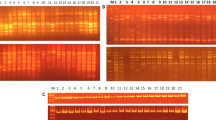Abstract
The genetic diversity and phylogenetic relationships of 29 East African highland banana (Musa spp.) cultivars and two outgroup taxa, M. acuminata Calcutta 4 and Agbagba were surveyed by RAPD analysis. A genetic similarity matrix was established based on the presence or absence of polymorphic amplified fragments. Phylogenetic relationships were determined by UPGMA cluster analysis. RAPDs showed that the highland bananas are closely related with a narrow genetic base. Nevertheless, there were sufficient RAPD polymorphisms that were collectively useful in distinguishing the cultivars. The dendrogram was divisible into a major cluster composed of all the AAA highland banana cultivars and Agbagba (AAB) and a minor cluster consisting of Kisubi (AB), Kamaramasenge (AB) and Calcutta 4 (AA). Several subgroups are recognized within the major cluster. RAPD data did not separate beer and cooking banana cultivars. Our study showed that RAPD markers can readily dissect genetic differences between the closely related highland bananas and provide a basis for the selection of parents for improvement of this germplasm.
Similar content being viewed by others
Author information
Authors and Affiliations
Additional information
Received: 28 June 2000 / Accepted: 1 August 2000
Rights and permissions
About this article
Cite this article
Pillay, M., Ogundiwin, E., Nwakanma, D. et al. Analysis of genetic diversity and relationships in East African banana germplasm. Theor Appl Genet 102, 965–970 (2001). https://doi.org/10.1007/s001220000500
Issue Date:
DOI: https://doi.org/10.1007/s001220000500




